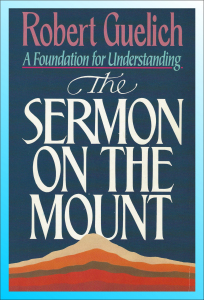Guelich Carefully Exegetes the Sermon on the Mount, Part 1
 Robert A. Guelich. 1982. The Sermon on the Mount: A Foundation for Understanding. Dallas: Word Publishing.
Robert A. Guelich. 1982. The Sermon on the Mount: A Foundation for Understanding. Dallas: Word Publishing.
Review by Stephen W. Hiemstra
The Sermon on the Mount is a surprisingly oblique, but self-contained, section in Matthew’s Gospel spanning from chapter 5 through verse 8:1. In the sermon, Jesus presents a kind of ordination service for the Apostles with crowds in the background looking on. What does he tell them? What are his priorities? How are we to interpret what is said?
In his commentary, The Sermon on the Mount, Robert Guelich starts by recognizing the enormity of the task, but lays out his reason for writing with these words:
Yet the absence of an extensive, critical, exegetical commentary in nearly four decades of biblical studies despite the vast literature on the Sermon provides both an opportunity and a need in New Testament (NT) studies (11).
Because NT scholarship is written both in German and English, Guelich’s studies in the U.S., Scotland, and Germany—his doctorate is from the University of Hamburg—suggests he has good preparation to write such a commentary. At the time he wrote, Guelich was a professor of NT at Fuller Theological Seminary.
Guelich’s literature review (14-22) is relatively brief but includes some interesting points. Citing Kissenger, Guelich notes that in early church (Ante-Nicene) writings chapters 5-7 of Matthew are cited more frequently than any other 3 chapters in the Bible (14). Augustine was likely the first to use the term, Sermon on the Mount (15). In his book, Summa, Thomas Aquinas distinguishes between “counsels” and “commandments” (advice versus obligation) placing Jesus’ teaching in the Sermon under “counsels” (15). Luther preached a series of sermons on the Sermon focused on “polemics against the papists” (16) while Calvin’s primary interest was on Jesus’ interpretation of law (17). Guelich describes Dietrich Bonhoeffer’s Cost of Discipleship as one of the better known treatments of the Sermon which, of course, focused on what disciples should do rather than on theological interpretation .
Guelich’s commentary is written in 10 chapters, including:
Introduction (pages 13-40);
The Setting of the Sermon on the Mount (Matt 4:23-5:2; 41-60);
The Gospel of the Kingdom (Matt 5:3-12; 62-112);
The Role of Discipleships (Matt 5:13-16; 119-131);
Jesus and the Law (Matt 5:17-20; 134-170);
The Greater Righteousness (Matt 5:21-48; 175-265);
On Doing Righteousness (Matt 6:1-18; 272-316);
The Life of Prayer (Matt 6:19-7:12; 321-379);
The Narrow Gate (Matt 7:13-27; 382-411); and
Epilogue (Matt 7:28-29; 414-419).
These chapters are preceded by a brief preface and followed by a bibliography and indices of authors and scriptural passages. The Beatitudes, which appear in Matthew 5:3-11, are treated primarily in chapter 3.
Let me turn briefly to the questions mentioned above.
What does Jesus tell them? Guelich (36-39) breaks the sermon into 3 parts: the Beatitudes, admonitions, and warnings. He sees the Beatitudes serving as a theological introduction expanded on in the admonitions and warnings of Matthew 5:17-7:27. Guelich sees the admonitions ending with the Golden rule in Matthew 7:12. The warnings then follow in 7:13-27. Ironically, the Lord’s Prayer appears among the admonitions in Matthew 6 and he sees the prayer providing structure to the remainder of the chapter and the first 12 verses of Matthew 7.
What are Jesus’ priorities? Jesus is addressing the Apostles to inaugurate his vision for discipleship in the new age of the Kingdom of Heaven, summarized especially in Isaiah 61 (37):
“…the LORD has anointed me to bring good news to the poor; he has sent me to bind up the brokenhearted, to proclaim liberty to the captives, and the opening of the prison to those who are bound; to proclaim the year of the LORD’s favor, and the day of vengeance of our God; to comfort all who mourn; to grant to those who mourn in Zion…” (Isa 61:1-3 ESV)
These priorities are captured in the Beatitudes. They are credible, in part, because they appear almost verbatim in Luke 4:17-20 where Jesus gives his “call” sermon.
How are we to interpret what Jesus said? Guelich describes his interpretation method as “critical, historical” commentary. He writes:
“…this commentary offers a critical exegesis in that it makes use of the literary and historical critical tools include text, source, form, tradition, redaction, and structural criticism”. (23)
Guelich’s skill as an interpreter is reflected in the wide range of critical methods that he employs. For example, he carefully distinguishes 3 sources in Matthew’s Gospel: Q materials appearing in Matthew and Luke; Matthew’s redaction (things attributable only to Matthew); and other NT sources, such as Mark. This careful inventory of sources provides Guelich the ability to infer author intent and other things when discussing particular Gospel writers. He sees the end of the Sermon (Matt 7:28) being borrowed from Mark 1:22 and the prelude to the Sermon (Matt 4:23-5:2) appearing at Mark 1:39 (414-415). This insight places the Sermon early in Jesus’ ministry.
Robert Guelich’s commentary, The Sermon on the Mount, is one of the most carefully written and interesting commentaries that I have ever read. In part 2, I will focus in more depth on particular issues that he raises.
Guelich’s BS is from Wheaton College, his MS from the University of Illinois, and S.T.B. is from Fuller Theological Seminary. He has done post-graduate studies at University of Aberdeen (UK) and the University of Tübingen.





